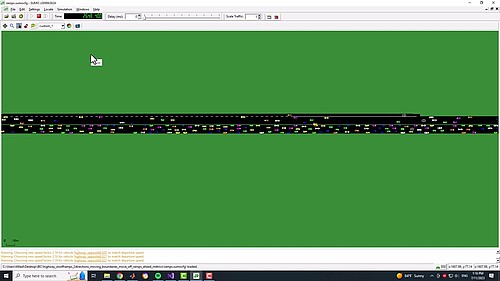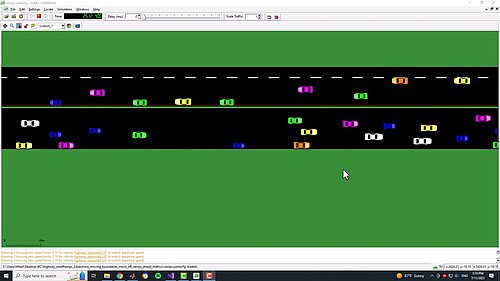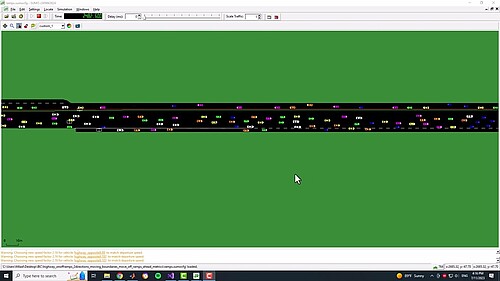Video Playlist 16: Internal boundary control in lane-free automated vehicle traffic: Comparison of approaches via microscopic simulation
The videos included in this playlist are part of the results discussed in the paper titled "Internal boundary control in lane-free automated vehicle traffic: Comparison of approaches via microscopic simulation".
The present work completes and validates the Internal Boundary Control (IBC) concept in a much more realistic way via microscopic simulation and active internal boundary (IB) moving, using the SUMO-based TrafficFluid-Sim simulation tool. To effectuate IBC, a Linear Quadratic Regulator (LQR), which is a feedback control scheme, is employed. In addition, to enhance the performance of LQR, a feedforward term, accounting for external disturbances, i.e. entering flows and on-ramp flows, is also designed, leading to an augmented LQR-FF control scheme.
This bi-directional highway used in simulation is 3 km long and was divided into six sections, each being 0.5 km long, for LQR design and IBC application according to Section 2 in the paper. Thus, the sections determine the scope of every sharing factor. The investigated highway comprises one on-ramp and one off-ramp per direction, yielding an inhomogeneous traffic situation in both space and time. With regard to the microscopic simulation, the vehicle movement strategy is employed with a time step of 0.2 s. The dimensions of the vehicles are determined by choosing randomly (with uniform distribution) one out of six "dimension classes". Also, the desired longitudinal speed assigned to a vehicle is chosen randomly (with uniform distribution) within the range [25, 35] m/s.
Prior to evaluating the IBC's performance, a simulation of the no-control case is presented. The videos associated with the activation of IBC follow.
No-control case
When no IBC is applied, the total mainstream width of the road is shared equally among the two traffic directions, and congestion is created in both of them, displaced in time according to the demand peaks. As can be seen in the video, congestion in each direction is created at the respective on-ramp sections, when the increasing mainstream demands of either direction plus the respective on-ramp flows exceed the respective (equal) road capacities and then spilled back to upstream sections.

LQR case
The IB is shifted to accommodate the prevailing demand as a result of activating the IBC. The LQR is a feedback controller that responds based on the relative density so as to mitigate or dissolve the congestion. The controller uses the relative densities to compute in real-time the sharing factors and the smooth IB curves, as detailed in the paper. LQR is seen in the video to avoid traffic congestion by appropriately shifting the IB according to the prevailing relative densities.

LQR-FF case
LQR may be efficient thanks to its feedback structure that reacts to the changes of traffic density caused by the inflows, without explicitly accounting for the actual inflow values. Having said that, it is worth investigating whether an extended LQR, namely LQR-FF, that includes, beyond the state feedback, also a feedforward term to explicitly account for the current inflow values, might provide additional benefits. Both LQR and LQR-FF appear equally successful in avoiding congestion in the investigated scenario, however LQR-FF is seen in the video to be more reactive than LQR, i.e. the occurring differences from the nominal value (0.5) are stronger. As a result, the two relative densities (RDs) in the two directions of every section are closer to each other, i.e. LQR-FF is better in balancing the RDs of the two directions. Other features of each controller are detailed and compared in the paper.

